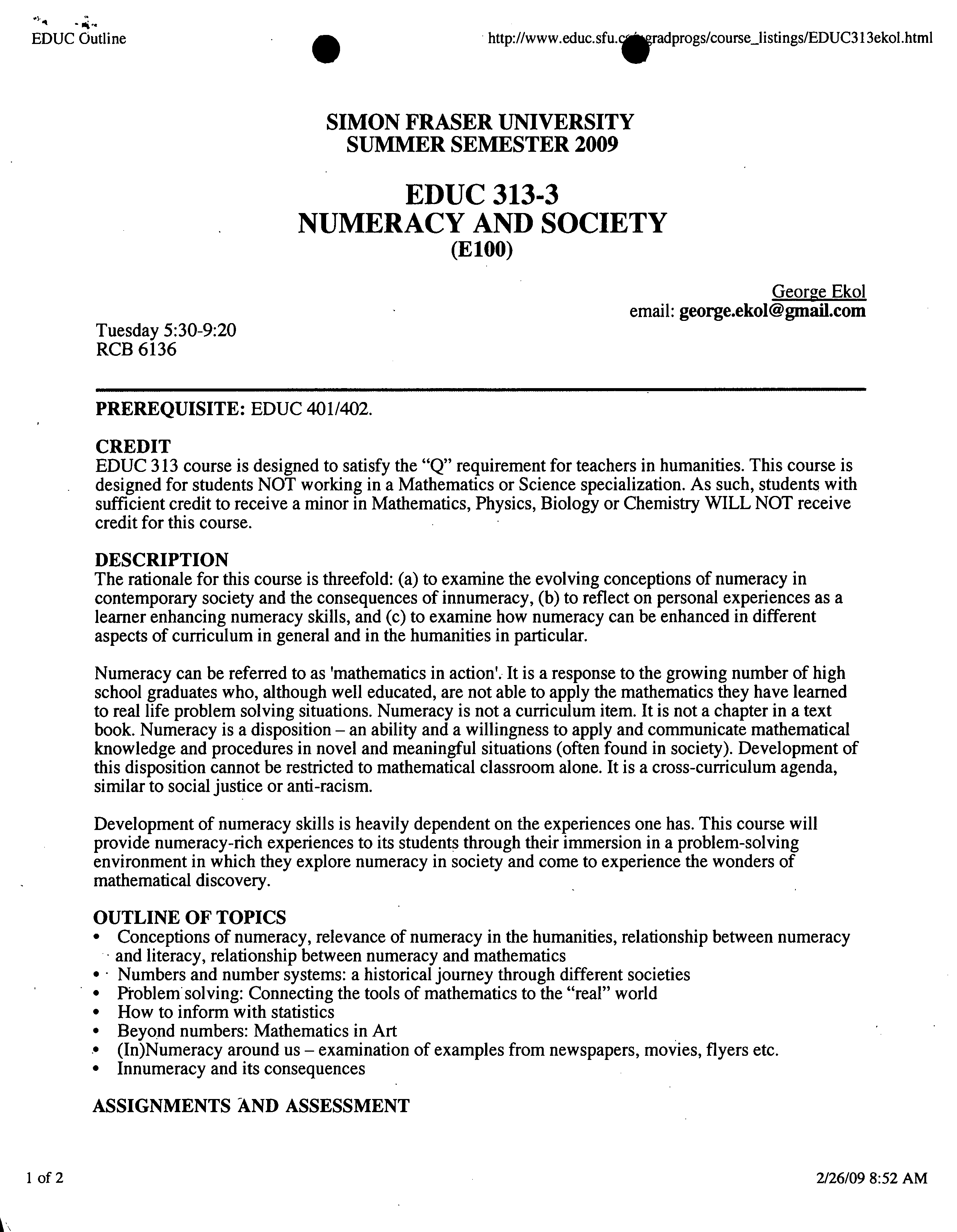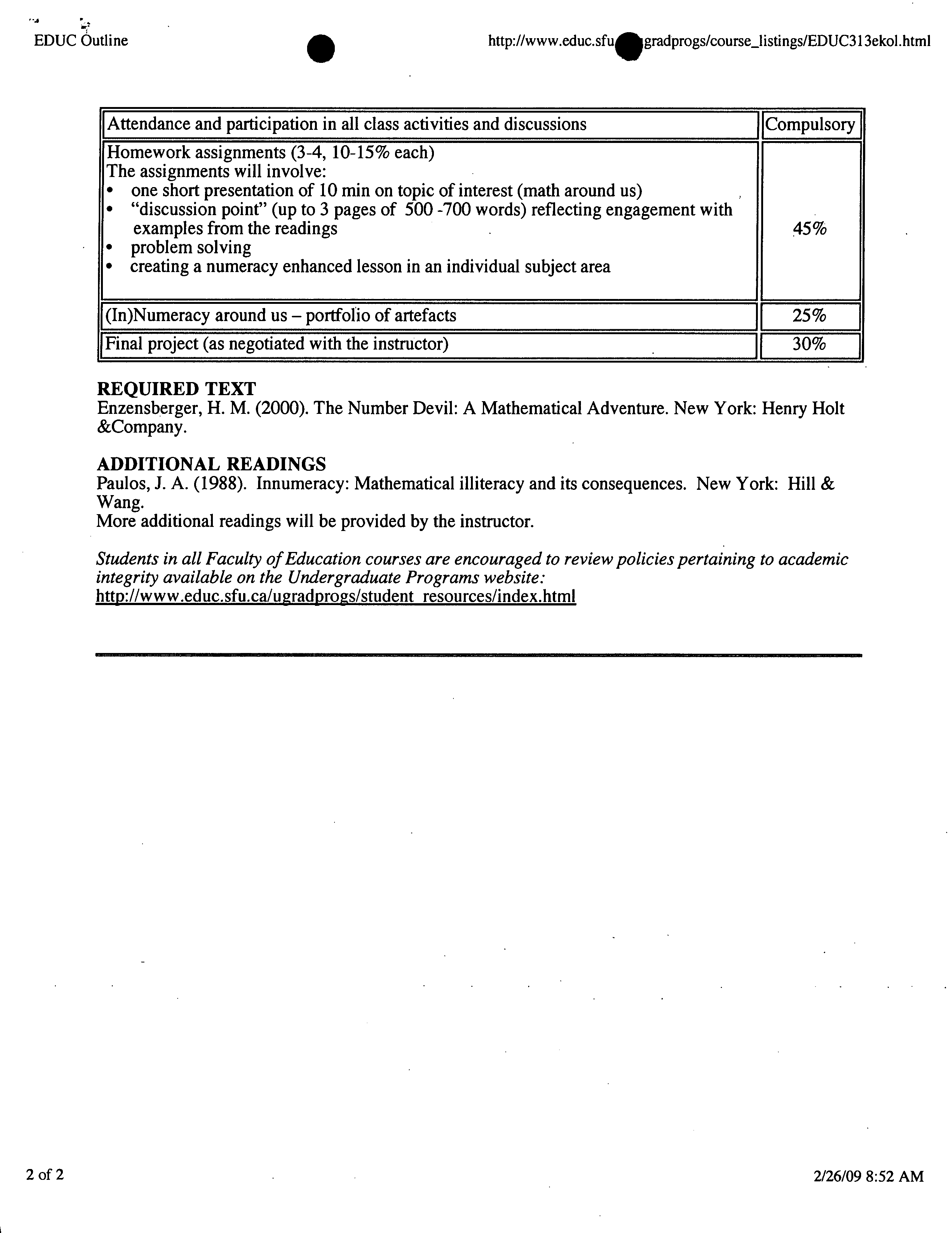.l
EDUC Outline
?
httP://www.educ.sfu.radros/course_Iistins/EDUC3 1
SIMON FRASER UNIVERSITY?
SUMMER SEMESTER 2009
EDUC 313-3 ?
NUMERACY AND SOCIETY ?
(E100)
George Ekol
email:
george.ekol@gmail.com
Tuesday 5:30-9:20
RCB 6136
PREREQUISITE:
EDUC
401/402.
CREDIT
EDUC 313 course is designed to satisfy the "Q" requirement for teachers in humanities. This course is
designed for students NOT working in a Mathematics or Science specialization. As such, students with
sufficient credit to receive a minor in Mathematics, Physics, Biology or Chemistry WILL NOT receive
credit for this course.
DESCRIPTION
The rationale for this course is threefold: (a) to examine the evolving conceptions of numeracy in
contemporary society and the consequences of innumeracy, (b) to reflect on personal experiences as a
learner enhancing numeracy skills, and (c) to examine how numeracy can be enhanced in different
aspects of curriculum in general and in the humanities in particular.
Numeracy can be referred to as 'mathematics in action'. It is a response to the growing number of high
school graduates who, although well educated, are not able to apply the mathematics they have learned
to real life problem solving situations. Numeracy is not a curriculum item. It is not a chapter in a text
book. Numeracy is a disposition - an ability and a willingness to apply and communicate mathematical
knowledge and procedures in novel and meaningful situations (often found in society). Development of
this disposition cannot be restricted to mathematical classroom alone. It is a cross-curriculum agenda,
similar to social justice or anti-racism.
Development of numeracy skills is heavily dependent on the experiences one has. This course will
provide numeracy-rich experiences to its students through their immersion in a problem-solving
environment in which they explore numeracy in society and come to experience the wonders of
mathematical discovery.
OUTLINE OF TOPICS
• Conceptions of numeracy, relevance of numeracy in the humanities, relationship between numeracy
and literacy, relationship between numeracy and mathematics
Numbers and number systems: a historical journey through different societies
• Ptoblem solving: Connecting the tools of mathematics to the "real" world
• How to inform with statistics
• Beyond numbers: Mathematics in Art
• (In)Numeracy around us - examination of examples from newspapers, movies, flyers etc.
• Innumeracy and its consequences
ASSIGNMENTS AND ASSESSMENT
1 of 2
?
2/26/09 8:52 AM
EDUC Outline
?
S
httP://www.educ.sfuradPros/course_listins/EDUC3
1 3ekol.html
Attendance and participation in all class activities and discussions
?
Ilcompulsoly
Homework assignments (3-4,10-15% each)
The assignments will involve:
• ?
one short presentation of 10 min on topic of interest (math around us)
• ?
"discussion point" (up to 3 pages of 500 -700 words) reflecting engagement with
examples from the readings
45%
• ?
problem solving
• ?
creating a numeracy enhanced lesson in an individual subject area
(In)Numeracy around us - portfolio of artefacts
25%
Final project (as negotiated with the instructor) ?
]
30%
REQUIRED TEXT
Enzensberger, H. M. (2000). The Number Devil: A Mathematical Adventure. New York: Henry Holt
&Company.
ADDITIONAL READINGS
Paulos, J. A. (1988). Innumeracy: Mathematical illiteracy and its consequences. New York: Hill &
Wang.
More additional readings will be provided by the instructor.
Students in all Faculty of Education courses are encouraged to review policies pertaining to academic
integrity available on the Undergraduate Programs website:
http://www.educ.sfu.ca/u2radero2s/student
resources/index.html
2of2 ?
2/26/09 8:52 AM


